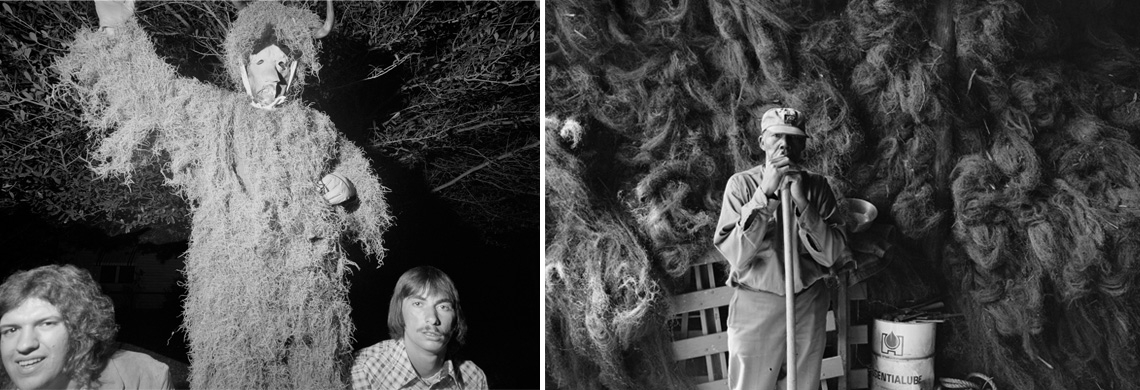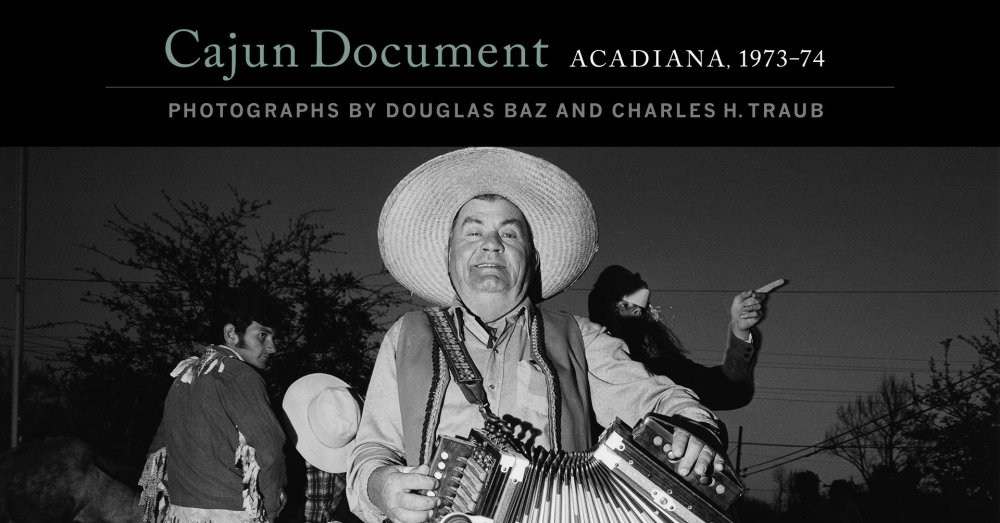What do we mean when we talk about Cajun Country? The simple answer is that the term is synonymous with Acadiana, a 22-parish region settled in the mid-18th century by exiles from present-day Nova Scotia. About 3,000 Acadians arrived in South Louisiana from 1764 to around 1785, and now, more than 250 years later, their creolized name, Cajun (derived from the French Acadien), can be found everywhere: there’s the Ragin’ Cajuns, the athletic moniker of the University of Louisiana at Lafayette (ULL). There’s the Cajun Heartland State Fair, held annually (pre-COVID) on the grounds of the Cajundome. And countless small businesses, from Cajun Power to Cajun Fitness, Cajun Broadband, and Cajun Mart, use the term to ground their names in a sense of place.
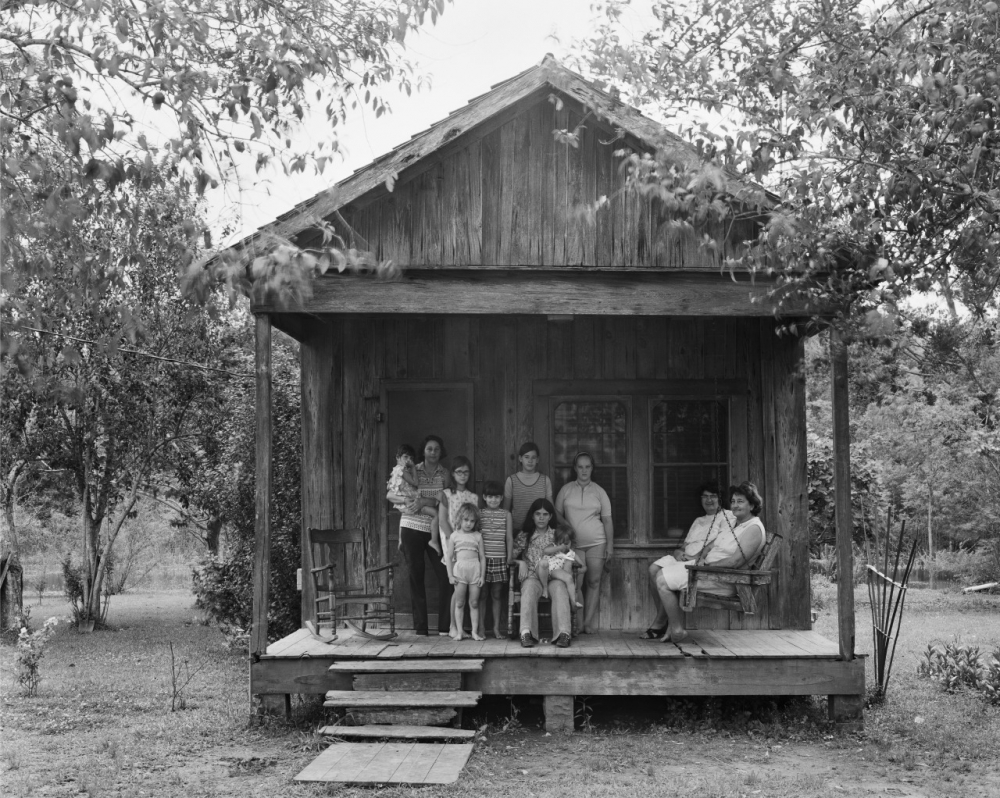
A family is shown on the porch of a 19th-century shotgun house in 1974. (THNOC, © Douglas Baz and Charles H. Traub, 2019.0362.24.1)
South Louisiana’s reputation as Cajun Country may seem as natural and inevitable as Spanish moss on a live oak tree, but it's actually a fairly recent phenomenon, the latest twist in a long story about Creole identity and United States race relations. When photographers Douglas Baz and Charles H. Traub spent six months in South Louisiana in the mid-1970s, creating the work now on view in THNOC’s new exhibition Cajun Document, the region was only just beginning to be known as Cajun Country. For two centuries, “Creole” had been the dominant term used to describe the region’s people and culture; Cajuns existed, but prior to the 1960s they did not self-identify as such in large numbers. For Cajuns were—and are—a subset of Louisiana Creoles. Today, common understanding holds that Cajuns are white and Creoles are Black or mixed race; Creoles are from New Orleans, while Cajuns populate the rural parts of South Louisiana. In fact, the two cultures are far more related—historically, geographically, and genealogically—than most people realize.
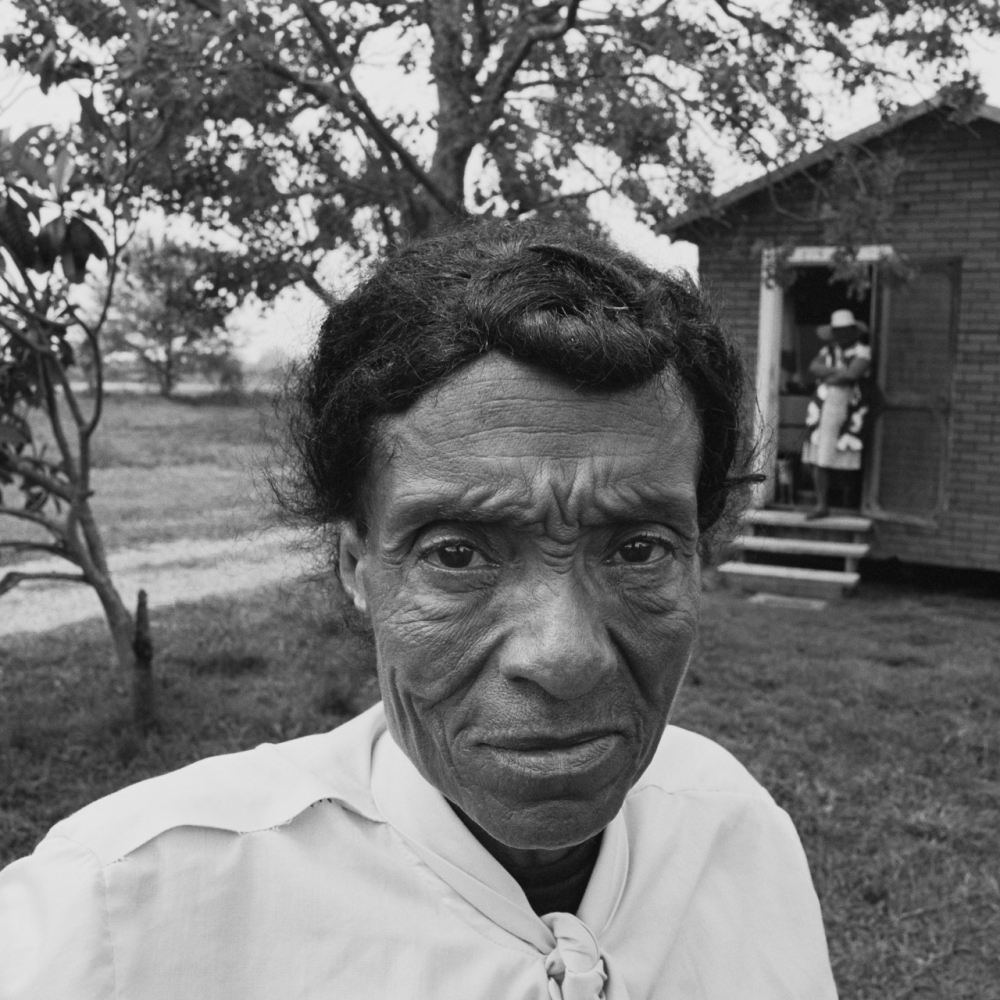
A Creole woman stands outside her home in Mansura, Lousiana, in 1974. (THNOC, © Douglas Baz and Charles H. Traub, 2019.0362.120.1)
So how did Cajuns come to stand in for all of Acadiana—even all of Louisiana, judging by the frequency with which tourists visit New Orleans believing it to be a hotbed of Cajun food and music? How did the region’s name, itself an homage to Acadian heritage, take root? And how has Creole identity fared in that process?
Part of the Creole World
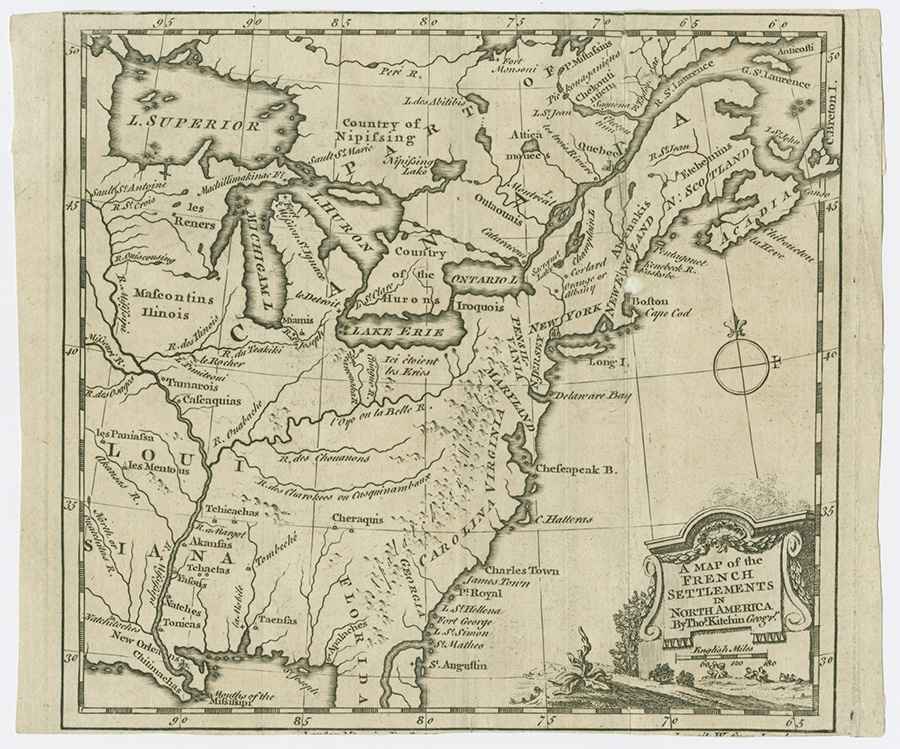
A 1747 map shows French settlements in North America, including Louisiana in the bottom left and Acadia, the original home of Acadians, in the top right. (THNOC, 2018.0394)
When the Acadians arrived in Louisiana, they were forced to adapt to the new environment—starkly different from the cold climate and British rule they had known in Canada. Part of that adaptation—building with rot-resistant cypress, growing rice instead of wheat—meant interacting with Native peoples and other inhabitants of the region. “A lot of people think the Acadians were the first ones here, but they weren’t,” said historian Shane K. Bernard, a curator for the McIlhenny Company and author of The Cajuns: Americanization of a People.
By the mid-18th century, Louisiana Creole identity had been two generations in the making. Contrary to popular belief today, the term carried no racial designation—one could be of entirely European, entirely African, or of mixed ancestry and still be a Creole. It simply meant someone who was native to the colony and, generally, French-speaking and Catholic. “Right from the start it was a very diverse community when the Acadians arrived,” said Christophe Landry, a scholar of Creole Louisiana. “[The Acadian exiles] intermingled, mixed, and adopted local culture, including Creole identity, within the first two generations.”
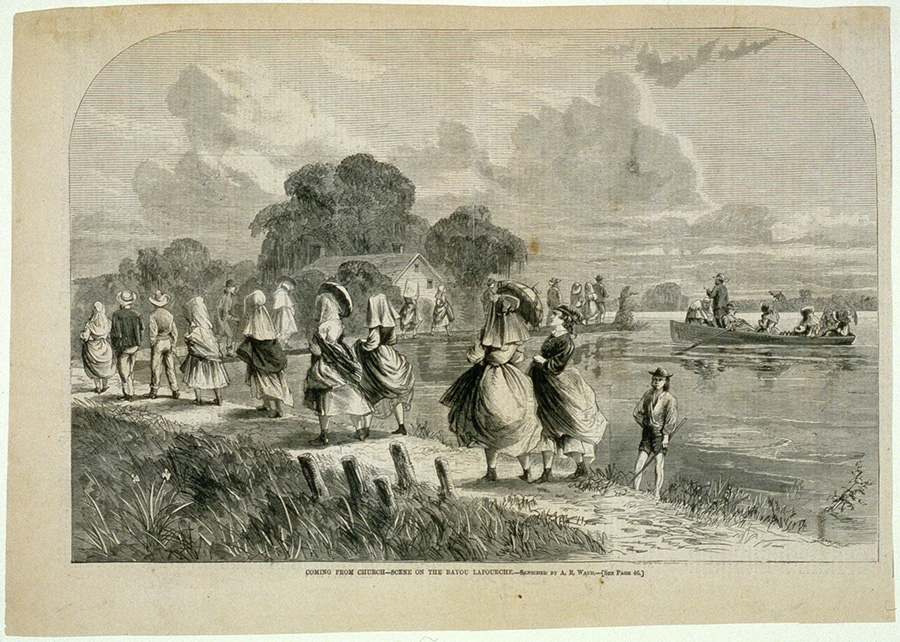
An 1860s drawing by Alfred Waud depicts people on Bayou Lafourche, part of the 22-parish area of South Louisiana designated Acadiana by the Louisiana state legislature in 1972. By this time this drawing was made, Acadian Creoles had been settled in the area for generations. (THNOC, the L. Kemper and Leila Moore Williams Founders Collection, 1956.31)
Acadians, enslaved West Africans, Houma, Chitimacha, Choctaw, German immigrants, Canadian trappers, French and Spanish settlers—all contributed to a process now known as creolization. Fueled by European colonialism and the transatlantic slave trade, creolization occurred throughout the Latin Caribbean world: different populations, most of them in lands new to them, blended their native cultural practices—culinary, linguistic, musical—to create new cultural forms. Gumbo drew upon West African and Native American sources (okra and rice from the former; filé, or crushed sassafras leaves, from the latter) and French culinary techniques (roux). Creolized French—Kouri-Vini, also known as Louisiana Creole—was, by the 1800s, in wide practice, including among Acadian descendants. The accordion, a star feature of both Cajun and zydeco music, was brought to the colony by German settlers, and its use was popularized in part by the enslaved people working those plantations.
Creolization, Bernard said, “was the beginning of becoming Cajun. . . . But the fact is a lot of Cajuns today don’t think of themselves as Creole. It all gets back to self-identification.”
Identity in Flux: Midcentury Americanization
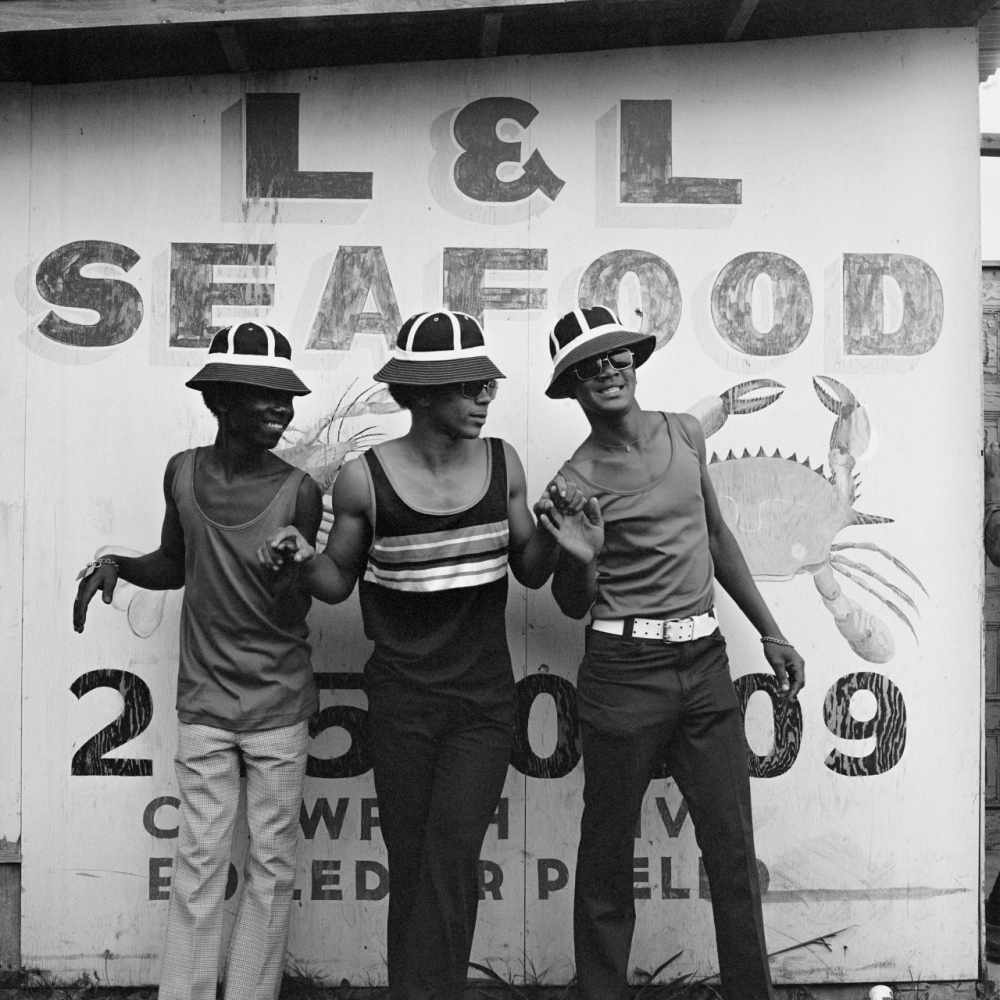
Three teenagers are pictured at the Carencro racetrack. (THNOC, © Douglas Baz and Charles H. Traub, 2019.0362.118.1)
For historians, identity evolution can be difficult to trace: the material record cannot replicate 200-year-old lived experiences and perspectives, but it does support the idea of an overarching créolité, or network of Creoleness, to which Acadian descendants belonged and self-identified throughout the 19th century. Much harder to substantiate is when those Acadian Creoles began calling themselves Cajun. It’s a matter of scholarly debate, but the current consensus holds that the term existed by the end of the 19th century. However, its usage does not appear to have been widespread, and it ranged from neutral to pejorative: “it wasn’t said with the kind of pride we see today,” Bernard said.
If the first step in becoming Cajun was creolization, then Americanization was step two. Starting in the 1920s, as part of nationwide effort to unite the country’s many ethnic groups under the English language, South Louisiana children began to be punished for speaking French in school. This development had a “profound effect on the culture,” Bernard said: children learned to self-censor their native tongue and, when they grew up, opted not to pass it on to the next generation.
Part and parcel of Americanization in the early 20th century was “its racial corollary,” Jim Crow segregation, Landry wrote in his 2015 doctoral thesis. Well established by the 1920s, Jim Crow separated white from nonwhite, funneling the historically diverse Creole populace into a racial binary at a time when its language traditions were under threat. The “one-drop rule” of racial purity underpinning segregation chipped away at white Creoles’ comfort with the “Creole” label. “With some white Creoles, when they learned the word could be connected to Blacks, they dropped the term,” said Herman Fuselier, host of the popular Zydeco Stomp radio show on Lafayette’s KRVS-FM and a specialist in Creole culture.
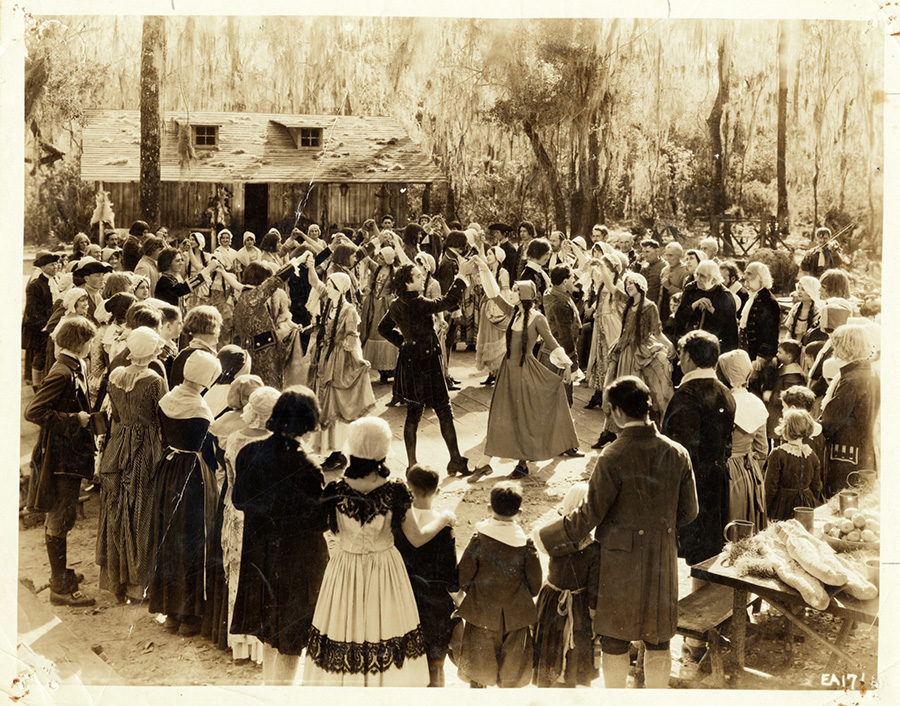 A publicity image from the 1929 film Evangeline depicts the world of the 18th-century Louisiana Acadians as a romantic, Eurocentric idyll. During the 1920s the hardening of the racial divide prompted white historians and community leaders to valorize the period of the Acadian expulsion, on which the story of Evangeline is based. (THNOC, 1997.62.4)
A publicity image from the 1929 film Evangeline depicts the world of the 18th-century Louisiana Acadians as a romantic, Eurocentric idyll. During the 1920s the hardening of the racial divide prompted white historians and community leaders to valorize the period of the Acadian expulsion, on which the story of Evangeline is based. (THNOC, 1997.62.4)
During the 1920s the hardening of the racial divide prompted white historians and community leaders to valorize the period of the Acadian expulsion, which is to say, before creolization. As Landry recounts in his doctoral thesis, the dream of Acadie blossomed in the popular imagination: Evangeline, the Longfellow poem from 1847, and two film adaptations of it (1913, 1929) were held up as a Eurocentric Acadian ideal. Tourism to Nova Scotia, based on interest in the Acadians, rose. Underpinning the Acadian craze, Landry argues, was a desire by white Creoles to reach back in time “to a romanticized, commodified, whitened Acadian identity.”
World War II was a turning point in the process of shifting Cajuns away from their Creole roots and toward the burgeoning American mainstream. Louisiana Creoles had kept a proud distance from Anglo-American culture going back to the colony’s transition to US territory in 1803, but after the war, “a lot of Cajuns came back . . . changed, very proud to be American,” Bernard said. “Even if you were on the home front, if you were the loved one of someone serving overseas, you felt swept up in the wartime fervor.” The introduction of television in the 1950s further solidified local ties to mainstream America.
By the 1960s, South Louisiana’s francophone heritage was due for a revival, after so many years of English-forward Americanization in the region. Although many whites still identified as Creole, segregation and the Acadian-focused heritage movement of the 1920s had conscripted white and nonwhite residents of South Louisiana into increasingly separate, racialized spheres—Acadian and Creole. The revival movement to come would separate those categories even further, turning Acadian into Cajun in the process.
The Cajun Revival
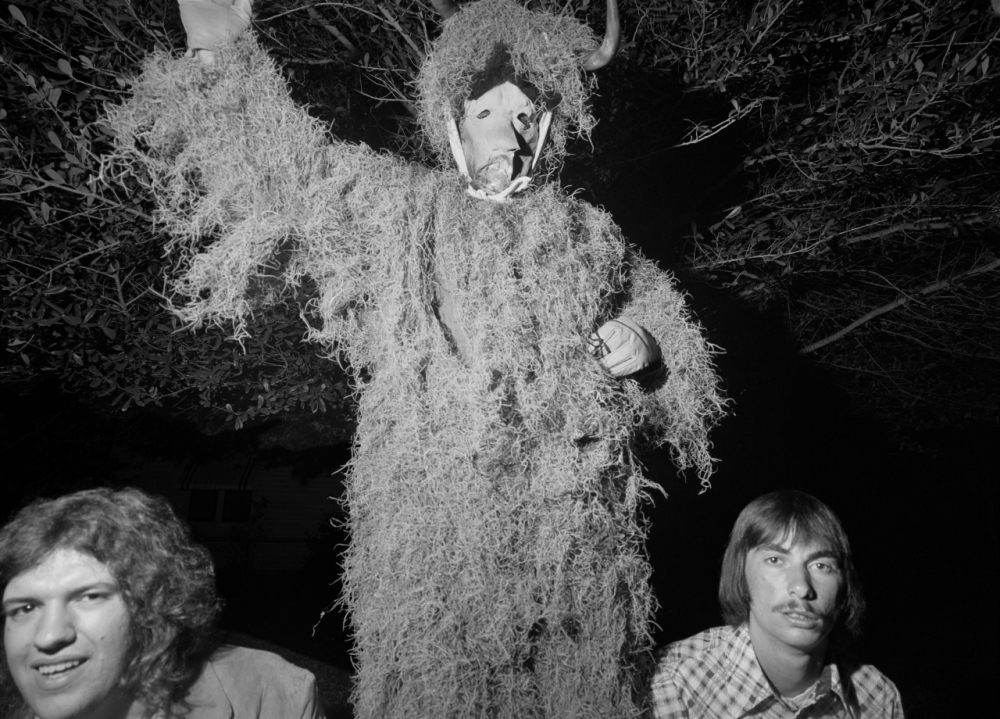
A man at a Mardi Gras celebration in the town of Mamou dons a suit made of moss. (THNOC, © Douglas Baz and Charles H. Traub, 2019.0362.81.1)
In 1963, KATC-TV, officially the Acadian Television Company, received an invoice with a remarkable typo. The vendor had mistakenly addressed the invoice to the “Acadiana” Television Company. The musical-sounding word immediately resonated as a way to define the station’s broadcast area, and KATC began using it regularly. “Acadiana” as a place-name was born.
Soon after, in 1965, Thomas J. Arceneaux, then dean of the College of Agriculture at the University of Southwestern Louisiana (now ULL), unveiled his design for the “flag of the Louisiana Acadians,” now widely known as the flag of Acadiana. “The flag and the name were really more successful than anyone ever intended,” Bernard said. “By the early ’70s they’re already being used in the names of businesses; they’re flying from flagpoles over City Hall, just all over the place.” In 1972, the state legislature officially recognized Acadiana, delineating a 22-parish chunk of the state, which is about a third of the state's 64 parishes.
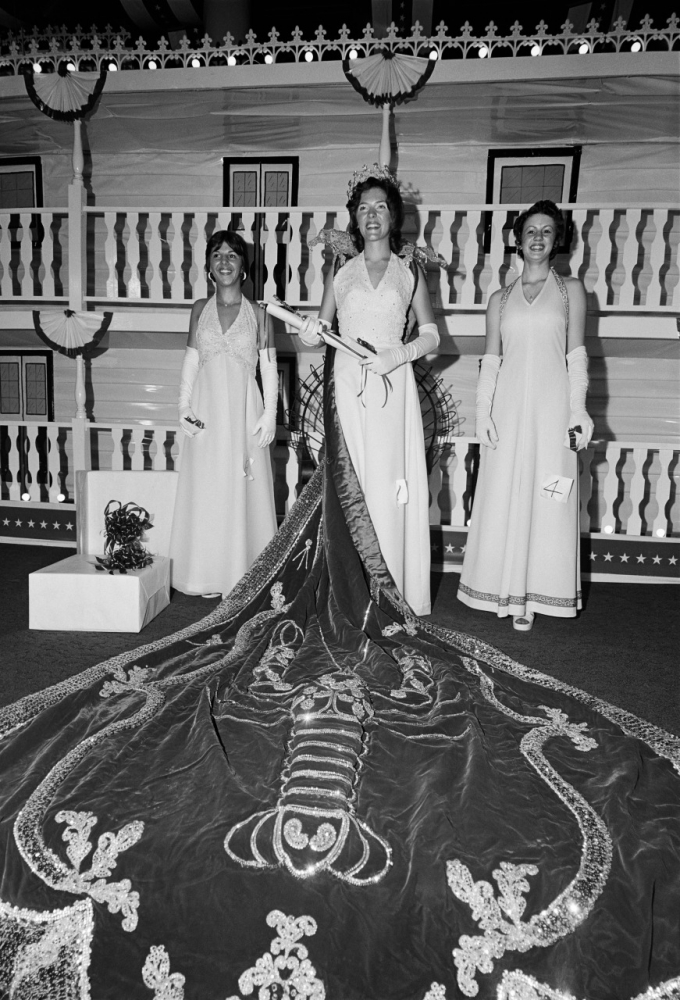
Faux royalty at the Breaux Bridge Crawfish Festival, 1974. (THNOC, © Douglas Baz and Charles H. Traub, 2019.0362.45.1)
Even so, the region’s growing pride in its Acadian heritage held tension along white sociocultural lines, best exemplified by the 1968 establishment of the Council for the Development of French in Louisiana (CODOFIL). A state-funded agency, the organization was founded to revive the French language in the area. However, it approached the creolized French spoken over the previous 200 years as an aberration: the council imported teachers from outside the country to teach Continental French in local schools. Its membership and patronage was overwhelmingly white and bourgeois; events were fancy affairs—“balls and tuxedos and gowns and cigars and banquets,” Landry said—where French opera was celebrated and traditional Cajun and Creole music was treated as a sideshow.
By that time, Cajun music’s profile had been steadily on the rise. In 1964 the fiddle player Dewey Balfa and a group of Cajun musicians made a triumphant appearance at the renowned Newport Folk Festival, where they received a standing ovation. Nationwide, there was a growing appetite for ethnic folk music. Outside appreciation and local pride formed a sort of feedback loop, building grassroots support for Cajun culture writ large. 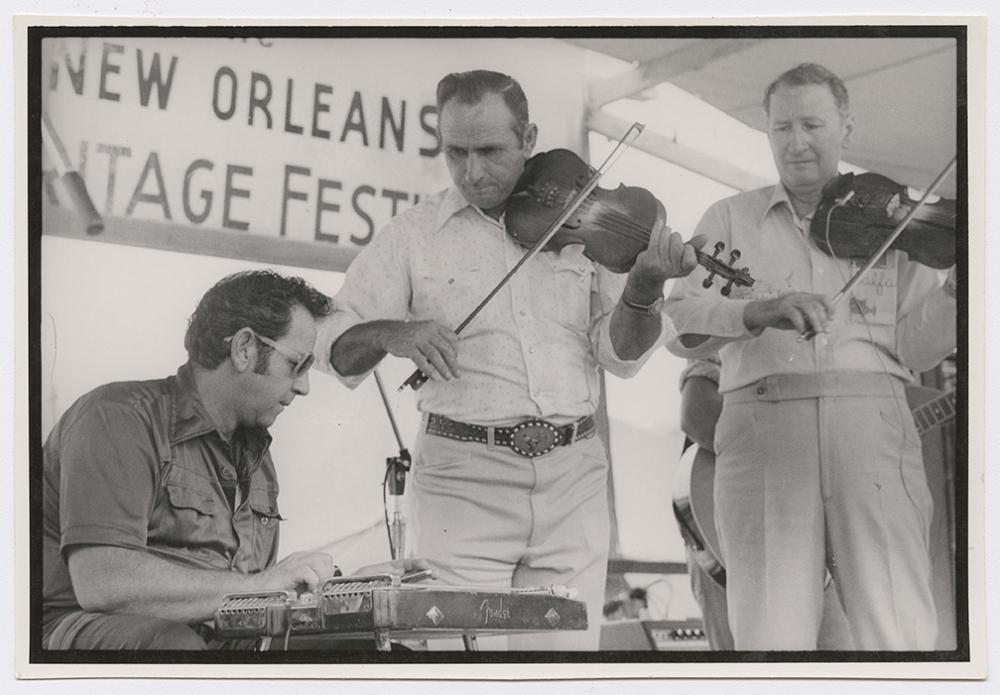 Dewey Balfa (right) plays with the Balfa Brothers at the 1979 New Orleans Jazz and Heritage Festival. (Photograph by Michael P. Smith, © THNOC, 2007.0103.4.697)
Dewey Balfa (right) plays with the Balfa Brothers at the 1979 New Orleans Jazz and Heritage Festival. (Photograph by Michael P. Smith, © THNOC, 2007.0103.4.697)
As the 1970s progressed, ethnic-pride movements began to pop up around the country, inspired by the successes of the civil rights era. The groundswell of Cajun pride was increasingly at odds with CODOFIL’s tendency to privilege “an elite, genteel Acadian minority,” as Bernard put it. Use of “Cajun” and self-identification as such began to skyrocket. Many in the “Acadian” camp objected to "Cajun," as it had a history of being used as a slur, to mean poor and trashy. (As Herman Fuselier recalled of his youth in the 1960s, “When a little white boy called me the n-word, the best comeback I could come up with was to call him a Cajun.”) The Cajun revival reclaimed the word, attaching it to the beloved food, music, and language of South Louisiana.
A slew of other developments followed: the inaugural Tribute to Cajun Music, the forerunner to today’s Festivals Acadiens et Créoles, packed Blackham Coliseum in 1974, surprising organizers who weren’t sure a crowd would even show up. Inspired by the success of the event, one of the festival’s organizers, the ULL historian Barry Jean Ancelet, founded the Center for Acadian and Creole Folklore.
By the mid-1980s, the state was actively using the Cajun/Acadiana labels to market tourism to the region, and it was at this point that African Americans and Creoles of color began to fight for their own revival.
Being Creole in a Cajunized World
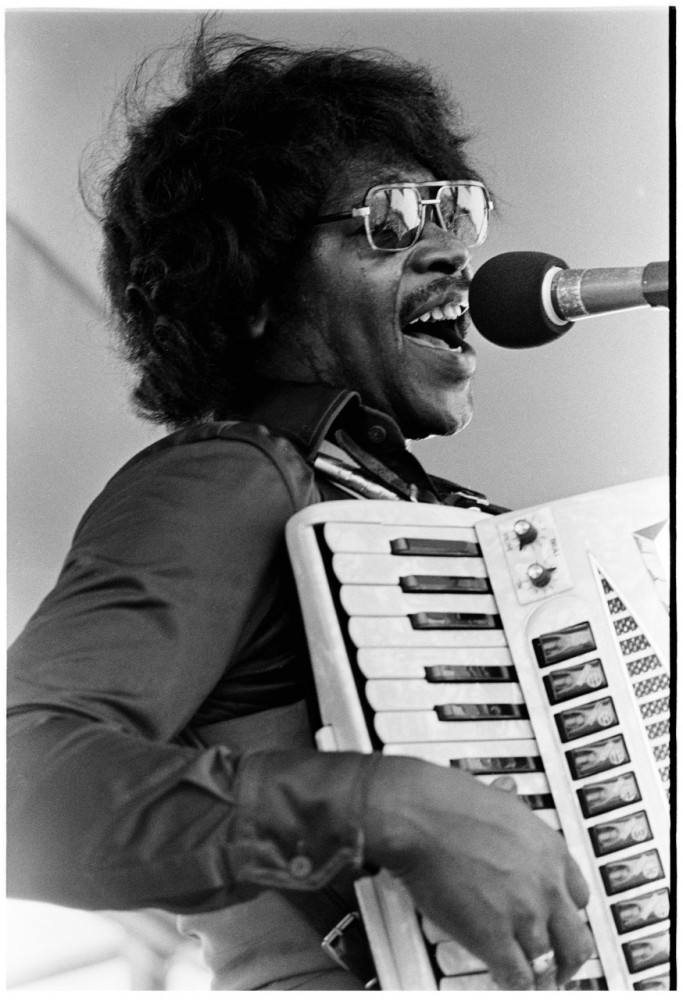
Buckwheat Zydeco, pictured here, reportedly would refuse to play a gig if his music was referred to as Cajun. (Photograph by Michael P. Smith, © THNOC, 2007.0103.1.1043)
In a 2018 article for the Journal of Cultural Geography, Alexandra Giancarlo includes an image of an advertisement created in 2016 by the Louisiana Department of Culture, Recreation, and Tourism: “Cajun 101,” it reads, followed by the following list—“Gumbo, Zydeco, Fais Do-Do.”
The ad exemplifies the complicated tangle of history, identity, and racial politics surrounding the Cajun revival and its legacy. Gumbo, as discussed previously, is not solely Cajun but, more broadly, Creole. Zydeco is musically, racially, and culturally different from Cajun music—“zydeco was sharecropper’s music, Black poor people’s music,” Fuselier said—and conflation of the two related forms has long irked its practitioners. “Buckwheat Zydeco, he had in his contract that his music couldn’t be described as Cajun music, and if it was, the gig would be canceled,” Fuselier said.
This sensitivity to mislabeling is not simply about music; it’s part of the complicated racial subtext of “Cajunization,” to use the term coined in 1991 by cultural geographer Cécyle Trépanier. The lasting dominance of the Cajun revival, compounded by the flattening effect of tourism marketing, has largely erased small-town and rural Creoles of color from popular depictions of their own culture. Similarly, the contributions of Native Americans, African Americans, Vietnamese, and other significant historical populations have been overshadowed by the “Cajun” brand. While that brand was being built, in the 1960s and ’70s, Creoles of color were continuing to fight for basic equality as American citizens; they did not have the luxury or the systemic power to advocate for Creole identity alongside Cajun. “Only recently have they been able to shift their energies to the promotion of their unique identity,” said Giancarlo.
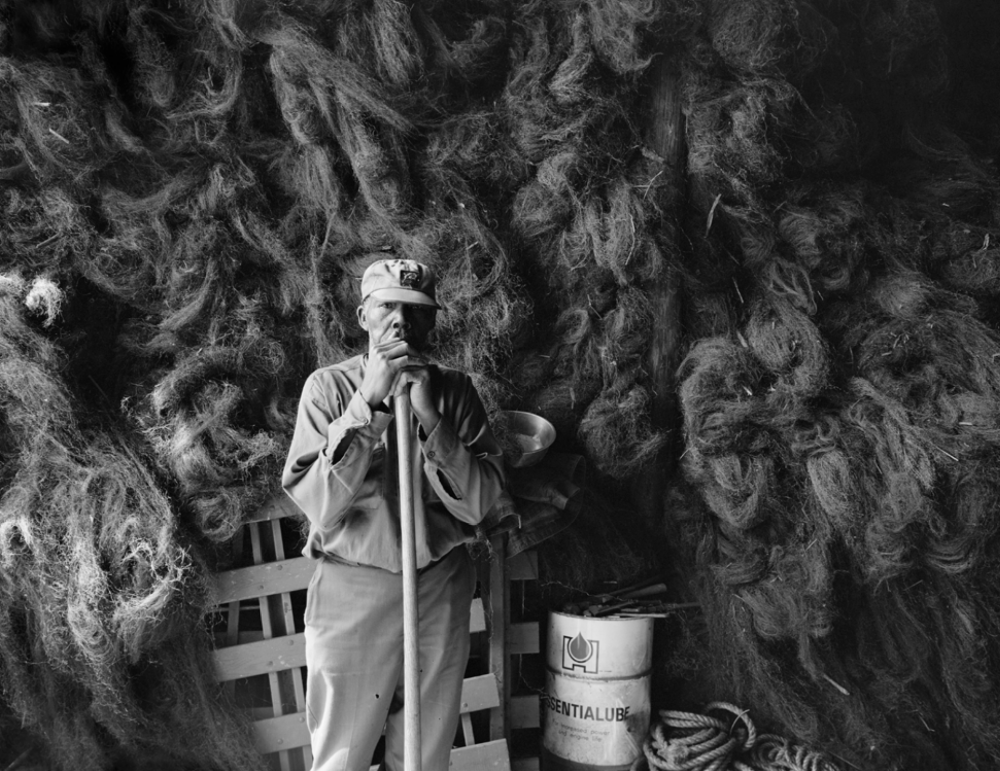
A moss-gin worker is pictured in Labadieville, Louisiana. (THNOC, © Douglas Baz and Charles H. Traub, 2019.0362.71.1)
That effort has included the 1982 formation of the Un-Cajun Committee, a group of African Americans and Creoles of color who protested the 1984 naming of the Cajundome and Cajun Field. According to Giancarlo, some in the Black community regarded “public events and landmarks bearing the descriptors ‘Cajun,’ or ‘Acadiana’ . . . as not only offensive but inaccurate as they do not capture the region’s true character.”
The advocacy group C.R.E.O.L.E. Inc. formed in 1987 and led youth outreach and public-awareness projects before going dormant in the late 1990s. (It was revived in 2015 and remains in operation today.) The year 1987 also saw the debut of a Creole flag, which incorporates insignia from colonial France, West Africa, and colonial Spain into its design. Creole magazine, a Lafayette-based monthly focusing on issues in the Black community, ran for several years in the 1990s.
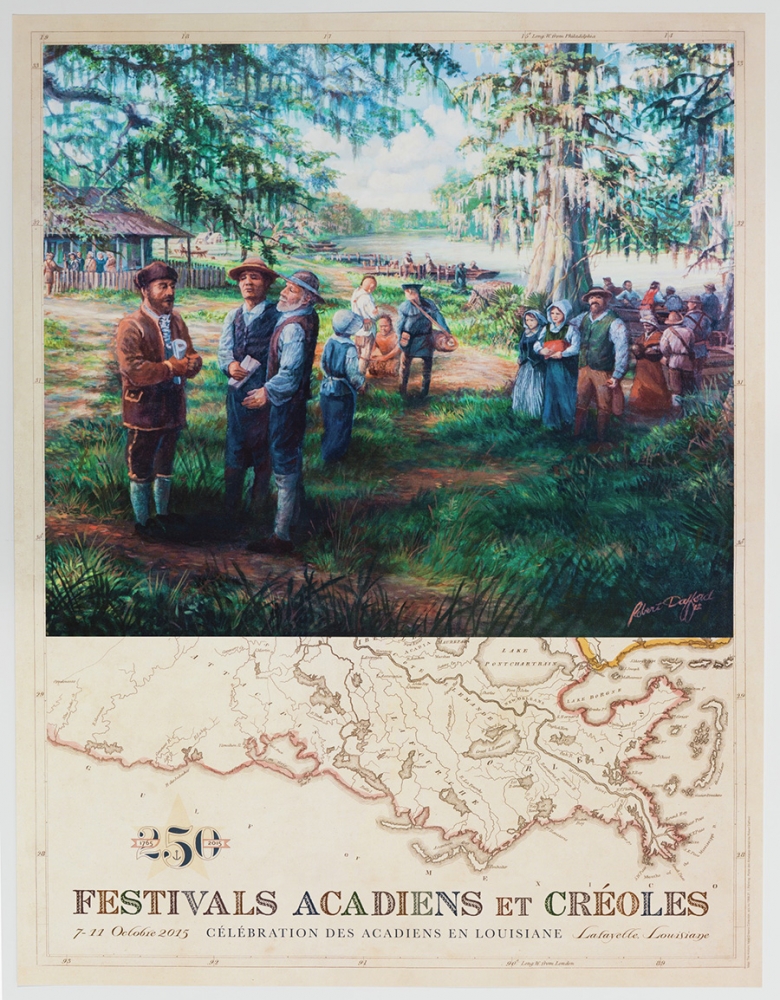 In 2008, Festivals Acadiens changed its name to Festival Acadiens et Créoles. (THNOC, gift of Megan Barra, 2015.0444.2)
In 2008, Festivals Acadiens changed its name to Festival Acadiens et Créoles. (THNOC, gift of Megan Barra, 2015.0444.2)
No longer known as Acadian Creoles, Cajuns remain the poster children for all of Acadiana, but there have been recent attempts to diversify representation of the region. In 2008, responding to the push for inclusivity, Festivals Acadiens changed its name to Festivals Acadiens et Créoles. The Louisiana Department of Culture, Recreation, and Tourism has also created a “Creole Country” map highlighting the art and history of Creoles of color. In the academic world, Cajun and Creole are increasingly presented alongside each other, twisted siblings of the racial- and cultural-identity wringer.
“History is always messy,” Landry said. “People tend to say that Creole is complicated because it involves people of different racial identities . . . whereas Cajun is predominantly people who identify as white, so it seems simple. But in fact it’s all part of the complex nature of identity evolution.”
This story appears in the Summer/Fall 2020 issue of The Historic New Orleans Collection Quarterly. To receive the Quarterly in print, become a member!
Explore Acadiana of the 1970s with THNOC's exhibition and book Cajun Document: Acadiana, 1973-74.
About The Historic New Orleans Collection
Founded in 1966, The Historic New Orleans Collection is a museum, research center, and publisher dedicated to the stewardship of the history and culture of New Orleans and the Gulf South. Follow THNOC on Facebook or Instagram.

